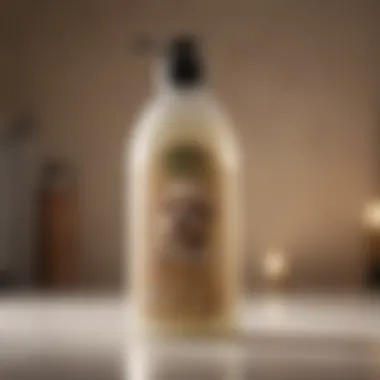Expert Advice on Choosing the Perfect Shampoo and Conditioner for Your Puppy's Health


Pet Grooming Essentials
As a devoted pet owner, ensuring the proper grooming of your young canine companion is paramount. Selecting the appropriate shampoo and conditioner for your puppy's delicate skin and coat is a crucial aspect of their grooming routine that demands thoughtful consideration. By understanding the key factors that dictate the choice of grooming products, you can provide your puppy with the care they deserve while promoting their overall health and well-being.
Factors to Consider When Choosing Shampoo and Conditioner for Puppies
When embarking on the journey of selecting shampoo and conditioner for your puppy, several factors come into play. First and foremost, it is essential to opt for products that are specifically formulated for puppies. Adult dog grooming products may contain harsh ingredients that could irritate your puppy's gentle skin. Additionally, consider your puppy's breed and coat type, as different breeds may have varying grooming requirements. For puppies with sensitive skin, hypoallergenic and fragrance-free options are preferable to prevent irritation. Furthermore, choosing products free from sulfates, parabens, and artificial dyes can safeguard your puppy from potential skin reactions.
Avoiding Harmful Ingredients for Puppy Grooming
In the realm of puppy grooming products, diligent label reading is of utmost importance. Avoiding certain harmful ingredients is vital to protecting your puppy's skin and coat. Ingredients such as artificial fragrances, sulfates, and parabens can cause skin irritation and allergic reactions. Opt for natural, organic products that prioritize the use of gentle, non-toxic ingredients to nurture your puppy's skin and maintain a healthy coat. Be wary of products containing alcohol, as they can dry out your puppy's skin and lead to discomfort. By carefully scrutinizing product labels and choosing formulations free from potentially harmful ingredients, you can safeguard your puppy's well-being during grooming sessions.
Introduction
When it comes to our furry companions, ensuring their well-being and health is paramount. Selecting the right shampoo and conditioner for puppies is a crucial aspect of their grooming routine that often gets overlooked. The coat and skin of young dogs have specific needs that differ from adult dogs, necessitating special care and attention. By choosing appropriate grooming products, pet owners can promote the overall health and comfort of their furry friends.
The first step in this comprehensive guide is understanding the needs of puppy hair. Puppy hair possesses unique characteristics that require gentle and specialized care. From the structure of their hair to growth patterns and texture differences, each aspect plays a role in determining the most suitable grooming products. Additionally, sensitive puppy skin adds another layer of consideration. Factors such as skin p H levels, sensitivity, and common skin issues further highlight the importance of selecting gentle and nurturing grooming products tailored to puppies' delicate skin.
Moving on to factors to consider in choosing shampoo and conditioner for puppies, hypoallergenic formulas emerge as a significant consideration. Opting for hypoallergenic products offers benefits such as reducing the risk of allergies and irritations, safeguarding the well-being of young dogs. Moreover, the debate between natural ingredients and chemicals comes into play. Exploring safe ingredients and avoiding harmful chemicals becomes imperative in ensuring the safety and health of puppies. Understanding the suitability of products based on a puppy's coat type is also essential. Whether the puppy has long, short, curly, or straight hair, knowing the specific coat care needs aids pet owners in selecting the most appropriate grooming products.
Awareness of harmful products to avoid is crucial in promoting the health of puppies. Toxic ingredients such as sulfates, parabens, and artificial fragrances should be carefully monitored to prevent adverse reactions in young dogs. Products like human shampoos, adult dog products, and medicated shampoos without vet approval are not suitable for puppies due to the harsh ingredients they may contain. Pet owners must be vigilant in examining product labels to safeguard their puppy's well-being.
Lastly, applying shampoo and conditioner correctly is key to effective grooming. Understanding the right bathing techniques for puppies, including gentle handling, proper rinsing, and avoiding eye and ear contact, ensures a stress-free and safe grooming experience. Conditioning tips such as evenly distributing conditioner, thorough rinsing, and determining the frequency of conditioning help maintain a healthy and lustrous coat for puppies. By following these guidelines meticulously, pet owners can enhance their puppy's grooming routine and promote their overall health and happiness.
Understanding the Needs of Puppy Hair
In the intricate world of puppy grooming, understanding the specifics of puppy hair is paramount. Puppy hair has distinct characteristics that require special attention and care. The composition of puppy hair, including its structure, growth patterns, and texture differences, plays a crucial role in maintaining the overall health and appearance of the puppy's coat. Identifying these key aspects not only aids in selecting the right grooming products but also ensures that the puppy's fur remains healthy and lustrous.
Puppy Hair Composition
Structure of Puppy Hair
Delving into the structure of puppy hair unveils a fascinating complexity. The unique composition of puppy hair differs from adult dog hair in terms of thickness and density. Understanding this variance is essential as it influences how grooming products interact with the puppy's coat. Puppy hair tends to be softer and more delicate, requiring gentle care to prevent damage. This characteristic makes the structure of puppy hair a crucial consideration when choosing suitable shampoos and conditioners.
Growth Patterns


The growth patterns of puppy hair follow a distinct trajectory. Unlike mature dog hair, puppy hair undergoes specific growth stages that impact its texture and length. By comprehending these growth patterns, pet owners can tailor their grooming routines to suit the puppy's evolving coat. Recognizing the nuances in growth patterns enables the selection of grooming products that cater to the unique needs of puppy hair.
Texture Differences
Texture differences in puppy hair showcase a diverse range of variations. From silky smooth to dense and wiry textures, puppy coats exhibit a spectrum of tactile qualities. Each texture type requires a different approach to grooming to maintain optimal health and aesthetics. Being mindful of these texture differences assists in selecting the appropriate shampoo and conditioner formulations that align with the specific needs of the puppy's coat.
Sensitive Puppy Skin
Puppy skin is incredibly delicate and prone to sensitivity, necessitating gentle yet effective grooming practices. Various factors such as skin p H levels, skin sensitivity, and common skin issues play a pivotal role in determining the appropriate grooming products for puppies.
Skin pH Levels
The p H levels of puppy skin are distinct from those of adult dogs, making it more susceptible to irritation. Maintaining the ideal pH balance is critical in preserving the skin's natural protective barrier and moisture levels. Understanding the significance of skin pH levels aids in selecting grooming products that promote skin health without causing disruptions.
Skin Sensitivity
Puppy skin exhibits heightened sensitivity compared to mature dog skin. This sensitivity necessitates the use of gentle, hypoallergenic grooming products to prevent adverse reactions. Being aware of the puppy's skin sensitivity helps in avoiding ingredients that may trigger irritation or allergies, ensuring a comfortable grooming experience.
Common Skin Issues
Despite their young age, puppies can experience various skin issues such as dryness, flakiness, or itchiness. Identifying these common skin issues allows pet owners to address them promptly with suitable grooming products. By staying vigilant and informed about potential skin issues, pet owners can maintain the overall health and well-being of their furry companions.
Factors to Consider in Choosing Shampoo and Conditioner:
When it comes to selecting the right shampoo and conditioner for your precious puppy, various crucial factors need consideration to ensure their well-being and health. The products chosen should be gentle on the puppy's sensitive skin and tailored to their specific coat type. Opting for hypoallergenic formulas can significantly benefit your puppy by reducing the risk of allergies and irritations commonly caused by harsh chemicals. Additionally, prioritizing natural ingredients over chemicals can offer a safer grooming experience for puppies, minimizing the chances of adverse reactions. Understanding your puppy's coat type is essential in choosing the most suitable products that cater to their specific needs, whether they have long, short, curly, or straight hair. By carefully considering these factors, pet owners can ensure that their puppy's grooming routine promotes overall health and comfort.
Hypoallergenic Formulas:
Benefits of Hypoallergenic Products:
Incorporating hypoallergenic products into your puppy's grooming regimen can bring forth various advantages. These formulations are specially designed to minimize the likelihood of allergic reactions and skin irritations, making them an ideal choice for puppies with sensitive skin. The key characteristic of hypoallergenic products lies in their gentle and mild nature, free from common allergens that could trigger negative skin responses. By opting for hypoallergenic formulas, pet owners can prioritize their puppy's comfort and well-being while ensuring a safe and effective grooming experience.
Avoiding Allergies and Irritations:
One of the primary reasons to consider hypoallergenic products is to proactively avoid allergies and irritations that could stem from conventional grooming products. By choosing hypoallergenic formulas, pet owners can significantly reduce the risk of skin reactions, itchiness, or discomfort in their furry companions. The unique feature of hypoallergenic products is their hypoallergenic properties, which make them a reliable choice for puppies prone to sensitivities. Considering the health benefits and preventative measures they offer, hypoallergenic formulas serve as a valuable option for maintaining your puppy's skin health and overall well-being.
Natural Ingredients vs. Chemicals:


Safe Ingredients:
When pondering between natural ingredients and chemicals in grooming products, prioritizing safe ingredients can positively impact your puppy's grooming routine. Safe ingredients derived from natural sources are typically milder and less likely to cause adverse reactions, aligning with the goal of promoting your puppy's health and comfort. The key characteristic of safe ingredients is their gentle yet effective properties in cleansing and nourishing your puppy's coat and skin. By choosing products rich in safe ingredients, pet owners can foster a safe and nurturing grooming environment for their beloved puppies.
Avoiding Harmful Chemicals:
To safeguard your puppy's well-being, it is essential to steer clear of harmful chemicals that could potentially endanger their health. By avoiding harsh chemicals commonly found in grooming products, pet owners can prevent unnecessary exposure to substances that may cause skin irritations or other adverse effects. The primary benefit of steering clear of harmful chemicals is the reduced risk of skin issues and sensitivities in puppies, ensuring a healthier grooming routine overall. By opting for products free from harmful chemicals, pet owners can enhance their puppy's grooming experience while prioritizing their safety and comfort.
Suitability for Puppy's Coat Type:
Long, Short, Curly, or Straight Hair:
Understanding your puppy's coat type is vital in selecting grooming products that cater to their specific needs. Whether your puppy has long, short, curly, or straight hair, considering their unique characteristics is crucial in ensuring their coat remains healthy and lustrous. Tailoring products to match the requirements of different coat types can help maintain optimal cleanliness and texture, promoting a shiny and well-groomed appearance for your furry friend.
Specific Coat Care Needs:
Each coat type comes with distinct care needs, requiring specialized attention to keep it in top condition. Whether your puppy's coat requires extra moisture, detangling properties, or color enhancement, choosing products aligned with their specific care needs can work wonders in maintaining a healthy and vibrant coat. The unique feature of addressing specific coat care needs lies in enhancing the overall health and appearance of your puppy's fur, ensuring it remains glossy, soft, and free from tangles. By tailoring grooming products to suit your puppy's coat type, you can provide them with the individualized care they deserve, keeping their coat in prime condition with each grooming session.
Avoiding Harmful Products
Toxic Ingredients to Watch Out For
Sulfates
Sulfates are a common additive in many shampoos, known for their ability to create lather and cleanse effectively. However, these substances can strip the natural oils from a puppy's skin, leading to dryness and irritation. While sulfates may offer a deep cleaning experience, their harsh nature makes them unsuitable for puppies with sensitive skin. It is crucial to avoid sulfates in grooming products designed for young dogs to prevent skin discomfort and maintain a healthy coat.
Parabens
Parabens serve as preservatives in various cosmetic products, extending their shelf life. Despite their functionality, parabens have been linked to potential health risks, raising concerns among pet owners. Avoiding shampoos and conditioners containing parabens is essential, as these chemicals may disrupt a puppy's hormonal balance and cause skin irritations. Opting for paraben-free grooming products ensures a safer and gentler grooming experience for puppies, promoting their overall well-being.
Artificial Fragrances
Artificial fragrances are often added to grooming products to impart a pleasant scent. While enhancing the olfactory experience, these fragrances can contain hidden toxins that may trigger allergic reactions in puppies. Pet owners should be cautious when selecting shampoos and conditioners with artificial fragrances, as these substances can potentially harm a puppy's respiratory system and skin. Prioritizing fragrance-free grooming products is advisable to minimize the risk of adverse reactions and maintain a puppy's skin and coat health.
Products Not Suitable for Puppies


Human Shampoos
Human shampoos are formulated for human skin and hair, encompassing ingredients that may be too harsh or unsuitable for a puppy's delicate coat and skin. Using human shampoos on puppies can lead to imbalances in p H levels, causing dryness, itchiness, and discomfort. It is fundamental to choose grooming products specifically tailored for puppies to ensure gentle cleansing and proper care without any adverse effects on their skin and coat.
Adult Dog Products
Grooming products designed for adult dogs may contain formulations that are too intense or potent for a young puppy's requirements. The ingredients present in adult dog shampoos and conditioners might not cater to the sensitivity and unique needs of puppy skin and coat. Opting for products targeted towards puppies ensures a milder yet effective grooming routine, tailored to suit their developing fur and skin characteristics.
Medicated Shampoos without Vet Approval
Medicated shampoos are specifically formulated to address certain skin conditions or issues that require veterinary oversight. Using medicated shampoos without professional guidance can pose risks to a puppy's health, as these products contain active ingredients that may be too strong or inappropriate for general use. Seeking vet approval before incorporating medicated shampoos into a puppy's grooming regimen is essential, ensuring that the treatment aligns with the pet's specific needs and is administered safely and appropriately.
Applying Shampoo and Conditioner Correctly
In the realm of puppy grooming, mastering the art of applying shampoo and conditioner correctly is paramount. Not only does this practice promote the health and hygiene of your furry companion, but it also contributes to their overall well-being. By ensuring that the shampoo and conditioner are distributed evenly and thoroughly through the puppy's coat, you can effectively cleanse their skin and hair, providing a refreshing and nourishing experience. Proper application of these grooming products can help to maintain the natural oils in your puppy's skin and coat, preventing dryness and irritation. Remember, a happy and healthy puppy starts with a proper bathing routine.
Bathing Techniques for Puppies
Gentle Handling
When it comes to gentle handling during bath time, it is imperative to approach the task with care and sensitivity. Gentle handling involves using soft strokes and mild pressure to lather the shampoo and conditioner, ensuring a soothing and relaxing experience for your puppy. This method aids in reducing any potential stress or discomfort your puppy may feel during the grooming process. By incorporating gentle handling into your bathing routine, you establish a positive association with grooming, fostering trust and comfort between you and your furry friend.
Proper Rinsing
Proper rinsing is a vital step in the bathing process, as residual shampoo or conditioner left on your puppy's skin can lead to irritation and discomfort. Thoroughly rinsing out the grooming products ensures that all traces are removed, leaving your puppy's coat clean and residue-free. Paying attention to areas such as under the legs, around the ears, and the tail is crucial to prevent any leftover product from causing skin issues. With proper rinsing, you can maintain the freshness and cleanliness of your puppy's skin and coat, promoting a healthy grooming routine.
Avoiding Eye and Ear Contact
While bathing your puppy, it is essential to avoid contact with their sensitive areas such as the eyes and ears. Water and grooming products should be carefully applied around these delicate regions to prevent irritation or discomfort. Using a gentle touch and being mindful of your puppy's reactions can help in keeping them calm and relaxed during the bathing process. By avoiding eye and ear contact, you prioritize your puppy's safety and well-being, ensuring a positive grooming experience for both you and your furry companion.
Conditioning Tips for Puppy's Coat
Even Distribution of Conditioner
Ensuring an even distribution of conditioner throughout your puppy's coat is key to reaping its benefits effectively. By carefully applying the conditioner and working it through the hair strands, you can nourish and hydrate the coat, promoting softness and shine. This method helps in detangling the hair, making grooming easier and more enjoyable for both you and your puppy. With an even distribution of conditioner, you can enhance the texture and appearance of your puppy's coat, maintaining its health and luster.
Rinsing Out Thoroughly
Thoroughly rinsing out the conditioner after application is essential to prevent residue buildup and maintain the cleanliness of your puppy's coat. Residual conditioner can weigh down the hair and attract dirt, leading to hygiene issues over time. By rinsing out the conditioner completely, you ensure that your puppy's coat remains fresh and light, allowing it to breathe and grow without any hindrances. Keep in mind that thorough rinsing is a crucial step in the conditioning process, contributing to the overall health and appearance of your puppy's coat.
Frequency of Conditioning
Determining the frequency of conditioning your puppy's coat depends on various factors such as their breed, hair type, and activity level. While some puppies may benefit from weekly conditioning sessions, others with oilier coats might require conditioning less frequently. It is essential to observe your puppy's coat condition and adjust the conditioning frequency accordingly. Over-conditioning can lead to product buildup and weigh down the hair, while under-conditioning may result in dryness and tangles. Finding the right balance and frequency of conditioning is key to maintaining a healthy and vibrant coat for your furry companion.







